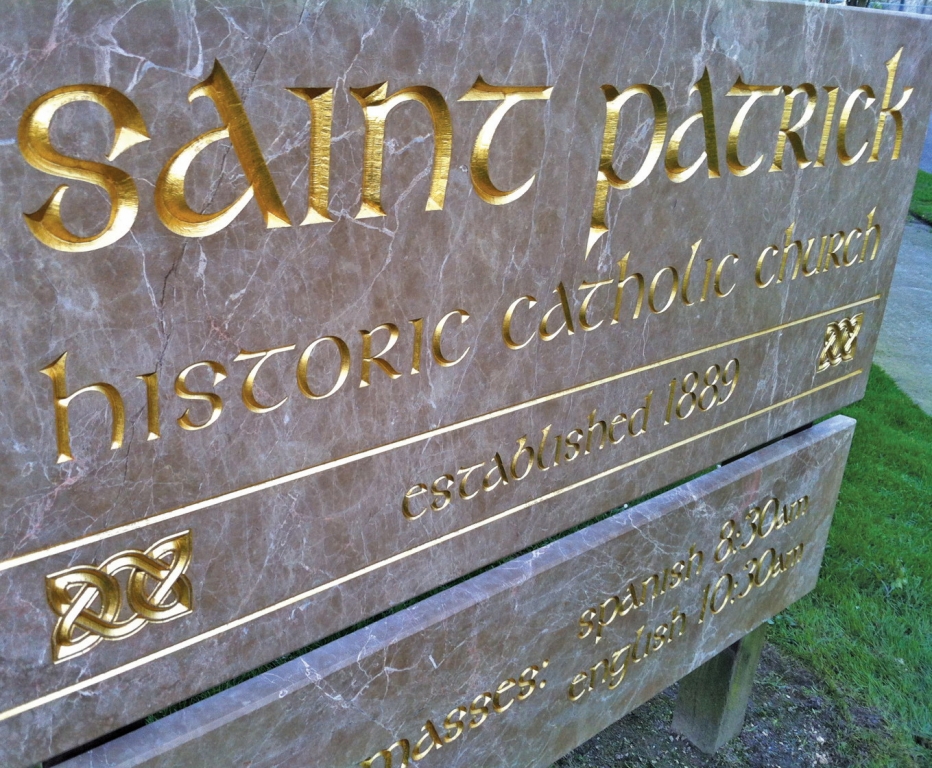After having worked for approximately 10 years as a tile-setting contractor, Peter Andrusko – a brickmason’s son – founded Written in Stone Productions, a business unit of the Andrusko Group (Portland, OR), and embarked upon a new career as a stonecarver. His career took a pivotal turn when Joseph Conrad, a veteran Minnesota carver, contracted Andrusko to create engraving stencils for one of Conrad’s commissions.
“I’d been developing sandblasting to decorate stone elements, but this was my first exposure to direct carving,” he said. “I was captivated by what I saw him do with his tools; he V-carved onto the stencils with a pneumatic hammer. I realized that lettering and signage presented much more expansive and interesting opportunities than other decorative elements. I immediately ordered my first set of carving tools.”
Andrusko has developed a reputation and expanded his business to include Portland and its environs, with several clients in Washington as well. His connections within the environmental-graphic-design (EGD) community take his work to points far beyond. This century, Andrusko and his team have built approximately 500 subdivision-monument signs, with tens of thousands more address plaques.
Andrusko adorned the Wagner Noel Performing Arts Center in Midland, TX with a donor-recognition wall that identifies approximately 100 Center benefactors. The wall, which spans approximately 350 sq. ft., meshes into a larger stone wall that spans the lobby’s perimeter. Andrusko carved the panels inside his studio, and numbered and boxed the components before encasing them in foam for shipping to the jobsite.
“It’s unusual for me to do a true V-cut into ¾-in.-thick stone tile offsite,” he said. “But, Debbie Shaw
[a senior designer for Portland-based Mayer/Reed Inc.] worked with me to design an outstanding system, and I was confident in my execution.”
Andrusko readily integrates traditional and modern production methods: “I have many stonecarving colleagues who eschew all modern technology in the studios. However, I incorporate software and automated production tools, whenever required, to create efficiency and beauty that couldn’t have existed with traditional methods.”
Advertisement
Predictably, his business in the market tanked along with the economic collapse that hit with full force in 2008. Andrusko admitted it was difficult to redirect his business, but he’s adapted to focus on architectural signage for building owners and managers, which includes those who seek LEED-compliant ratings for their structures, as well as bas-relief carving and other fine-art-engraving applications.
“I’ve been fortunate that many EGD providers and architects with whom I’ve partnered understand the artistic value of my work,” he said. “When a simple conversation answers my questions about form, size, material and color, a project practically designs itself.”
Andrusko primarily plies his trade with stone, but he also works with woods, glass, metals, clay and plastics. He begins with ink or pencil sketches and progresses through numerous software programs. Andrusko estimates he’ll use 10 different software programs to address the diverse design aspects – Adobe Photoshop, CorelDRAW, Vectric Aspire and others – of a typical project; some unusual projects require more, he said. Andrusko noted that, like software, carving media requires due consideration.
“Some hard materials, like granite, aren’t cut so much as they’re smashed and pounded into shape,” he said. “Softer stones, on the other hand, are cut using sharp, wet-honed cutting edges.”



 Tip Sheet3 days ago
Tip Sheet3 days ago
 Business Management1 week ago
Business Management1 week ago
 Women in Signs2 weeks ago
Women in Signs2 weeks ago
 Real Deal4 days ago
Real Deal4 days ago
 Editor's Note1 week ago
Editor's Note1 week ago
 Maggie Harlow2 weeks ago
Maggie Harlow2 weeks ago
 Line Time2 weeks ago
Line Time2 weeks ago
 Product Buying + Technology1 week ago
Product Buying + Technology1 week ago







